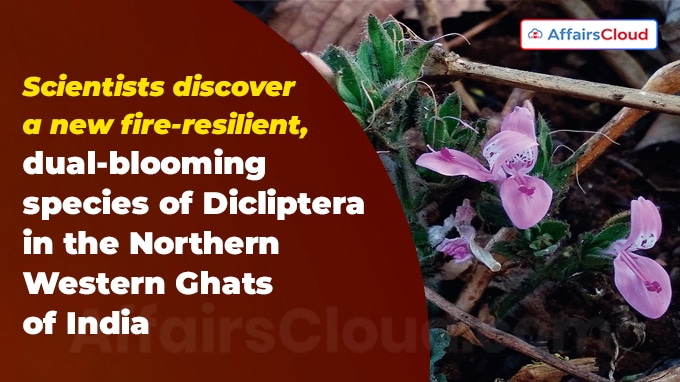 Scientists have discovered a new fire resilient dual blooming species of Dicliptera in the Northern Western Ghats of India. The new species genus Dicliptera, has been named Dicliptera polymorpha to reflect its diverse morphological traits.
Scientists have discovered a new fire resilient dual blooming species of Dicliptera in the Northern Western Ghats of India. The new species genus Dicliptera, has been named Dicliptera polymorpha to reflect its diverse morphological traits.
- The new species experienced the flowering triggered by the grassland fires and has an inflorescence structure that is rare in Indian species.
About the discovery:
i.The discovery was made by the team led by Dr. Mandar Datar, including Talegaon-Dabhade based botanist Adittya Dharap and Ph.D. student Bhushan Shigwan
ii.The species was collected from Talegaon- Dabhade, which is known region for its grasslands and fodder markets.
The first specimens were collected during the 2020 monsoon, and the population was monitored by Adittya Dharap for following years to confirm the consistency of its characteristics.
The species’ novelty was confirmed by leading global expert Dr. I. Darbyshire from Kew Botanic Garden, London the United Kingdom (UK). A research paper detailing this species was recently published in the prestigious journal Kew Bulletin.
Note: The Western Ghats is a focus of exploration of the Agharkar Research Institute (ARI), Pune, Maharashtra, an autonomous institute under the Department of Science & Technology (DST).
About Dicliptera polymorpha:
i.Dicliptera polymorpha is a distinctive species, known for its fire-resilient, pyrophytic habit and its unusual dual-blooming pattern.
ii.This species is taxonomically unique, with inflorescence units (cymules) that develop into spicate inflorescences. It is the only known Indian species with this spicate inflorescence structure, with its closest allied being found in Africa.
iii.The new species thrives on slopes in open grasslands of the northern Western Ghats, it blooms twice yearly ,post-monsoon (November–April) and during fires (May–June).
Agasthyamalai Bambootail: A new damselfly species with unique genetic traits discovered in the western ghats
A team of scientists from MIT World Peace University (MIT-WPU) and Christ College has discovered a new species of damselfly in the Western Ghats of Kerala, named Melanoneura agasthyamalaica, or the “Agasthyamalai Bambootail.”
- The new species, found near Peppara Wildlife Sanctuary located in Manjadininnavila, Thiruvananthapuram district, Kerala.It is visually distinct with a long black body, vivid blue marking, and a cylindrical, bamboo-like abdomen.
Genetic analysis:
i.The Agasthyamalai Bambootail is the 2nd species identified in the Melanoneura genus after Malabar Bambootail (Melanoneura bilineata), which was found in the Coorg-Wayanad region.
Crinum Andhricum: New Flowering Plant Discovered in Eastern Ghats
Botanists have discovered a new species of flowering plant named ‘Crinum andhricum’ in the Eastern Ghats of Andhra Pradesh(AP). The species was named after Andhra Pradesh in recognition of the State where it was first found.
- The new species was Collected in April 2023 by a team led by scientist L Rasingam from the Botanical Survey of India, Deccan Regional Centre in Hyderabad, Telangana.
- The species was found growing in the dry, rocky forests of the Sapparla hills in Alluri Sitarama Raju district at an elevation of 1,141 metres.
- The plant is closely related to Crinum amoenum and Crinum stracheyi.
Note: It is the latest addition to India’s Crinum species, bringing the total to 16, with several being endemic to India.
About Crinum andhricum:
i.Crinum andhricum has distinct features, including wider, oblanceolate perianth lobes (the outer part of the flower) , 12 to 38 flowers per cluster,and unique pedicelled flowers with a stalk-like structure.
ii.The waxy white flowers of Crinum andhricum bloom between April and June.
iii.The plant specimens have been preserved at the Botanical Survey of India’s Central National Herbarium,Howrah in West Bengal and the Deccan Regional Centre in Hyderabad.
Orchid species “Gastrodia lohitensis” discovered in Arunachal Pradesh
A team of Indian botanists has discovered a new leafless orchid species named Gastrodia lohitensis, in Lohit in Arunachal Pradesh(AR). The new species was named after Lohit district.
- The new species was found in bamboo thickets around Tezu, the orchid presents unique adaptations, thriving without sunlight by extracting nutrients from fungi in decomposing leaf litter.
- The team was led by Krishna Chowlu from the Botanical Survey of India(BSI), the team documented the discovery during May 2024 expedition.
- The new species stands 50-110 cm tall. It features include a pair of linear calli and ridges on its flower lip, distinguishing it from related Southeast Asian species.
IUCN criteria: Gastrodia lohitensis faces pressures from local land use, including bamboo harvesting and agriculture, leading researchers to categorised it as “Endangered” according to IUCN (International Union for Conservation of Nature) Red List criteria.
New Jumping Spider Species Discovered in Maharashtra
Atharva Kulkarni, a post-graduate student from Maharashtra has discovered a new jumping spider species named “Okinawicius tekdi” from a hill located in Pune city, Maharashtra. The species belongs to genus Okinawicius Prószyński, first described from India in 2016.
- The term “Tekdi” in Marathi translates to ‘hill’ and the species was named as a tribute to the geographical origin of the animal.
- Environmental science student Atharva Kulkarni discovered the species while studying spider diversity on Baner Hill,Pune.
- The findings have been published in the Journal of Arachnology.
Note:
i.The spider is distinguished by its morphological characteristics, especially in the female genitalia.
ii.A notable identification feature is the membranous coils of the copulatory ducts, which lie parallel to the surface.
iii.It is this peculiar feature identified by Prószyński (2016) that led to the reclassification of 8 species from the Pseudicius genus described by Eugene Simon in 1885 to Okinawicius.
Points to note-
The Ghats are mountain ranges in India, divided into three main regions:
- Western Ghats: Gujarat, Maharashtra, Goa, Karnataka, Kerala, and Tamil Nadu.
- Eastern Ghats: Odisha, Andhra Pradesh, Telangana, Tamil Nadu, and parts of Karnataka.
- Northern Ghats: A section of the Western Ghats, primarily in Maharashtra, including regions like the Sahyadri Hills.




